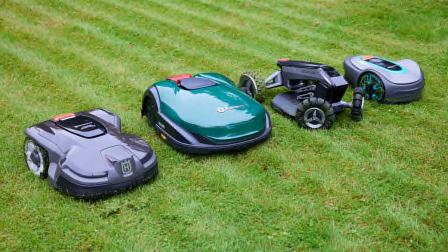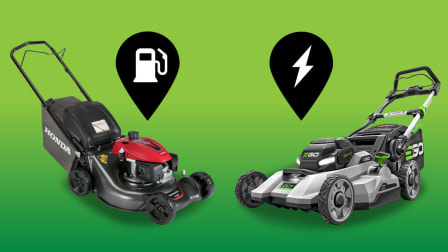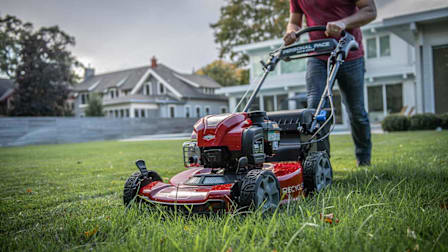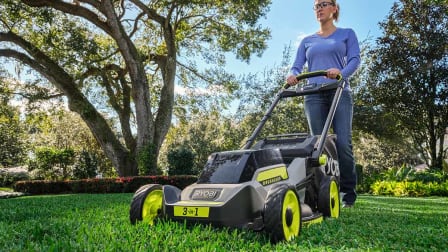When Is It Safe for Your Child to Mow the Lawn?
We offer some guidance on how to make the task safe, seamless, and maybe even fun for your kid or teen
When you shop through retailer links on our site, we may earn affiliate commissions. 100% of the fees we collect are used to support our nonprofit mission. Learn more.
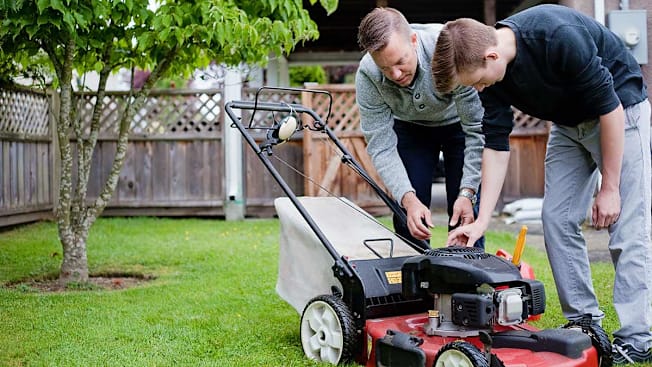
You can think of it as a rite of passage. There comes a time when a child is ready, maybe even willing, to mow the lawn. For many, it marks a glorious new chapter for parents and kids alike. Well, maybe.
It’s also an experience that’s ripe with risks and tough choices. Ashita Kapoor, associate director of product safety at Consumer Reports, says: “The combination of a powerful motor or engine, sharp blades, and flying debris can create a perfect storm of hazards. In the worst-case scenario, that can transform a routine yard task into a life-altering accident in mere seconds.”
- Mowers Safety: Age Recommendations How to Prevent Injuries
- Walk-Behind Mowers: Safety Features to Look For Best Walk-Behind Mowers for Young People 12 and Up
- Riding Mowers: Safety Features to Look For Best Ride-On Mowers for Young People 16 and Up
How Old Should a Child Be When They Start Cutting the Grass?
According to the American Academy of Pediatrics, a child should be at least 12 to operate a walk-behind mower and at least 16 to use a riding mower. This is echoed by the Consumer Product Safety Commission and safety experts at Consumer Reports.
“Younger children may lack the physical strength, judgment, and experience to safely control these machines,” Kapoor says. “As the Consumer Product Safety Commission firmly advises in their guidelines, children under 12 should never operate a push mower, and those under 16 should not use riding mowers. It’s also important to note that proper supervision and age-appropriate tasks are essential to preventing the thousands of lawn mower injuries that affect children annually.”
Even with these age recommendations in mind, parents should use their judgment as to whether their 12-year-old is ready. The AAP spells out what parents of course already know: To use a lawn mower, kids should be mature and strong enough for the job required, and they should demonstrate good judgement.
How to Prevent Injuries When Your Child Cuts the Grass
Before turning the mower over to your child or teen, make sure to take time to teach them how to prepare the lawn for mowing and how to use the mower itself—even if they’ve watched you do it dozens of times. Make sure your child is familiar with how the mower works and its safety functions (more on the equipment below). Demonstrate how to get the job done safely, especially if there are hills or trees in your yard to be mindful of.
Before mowing, you’ll also want to collect rocks, sticks, toys, or other items around the yard that could be kicked up and thrown by the mower. These objects can fly “like a bullet,” the AAP warns.
As Kapoor mentioned, both flying debris and the machinery of a lawn mower have the potential to cause serious injury. Thousands of children go to emergency rooms each year because of mowing accidents, according to the AAP, with injuries such as burns, fractures, and cuts. The worst of these injuries require amputation, according to the AAP and a 25-year review of lawn mower injuries to children.
Teens ages 14 to 17 are the group most likely to suffer from mower-related injuries, probably because they are of the age when many of them start cutting the grass. Children under 5 are also at elevated risk for mower injuries, in part because they’re injured as bystanders or as passengers on a riding mower. The AAP and the American Academy of Orthopaedic Surgeons, along with the Outdoor Power Equipment Institute, say that children should never ride as passengers on a mower. Instead, young children should stay inside, supervised, while mowing happens.
Even Votava confessed that, after having the work experience of mowing hundreds if not thousands of lawns, he almost lost his thumb one day when inspecting the pulley on his zero-turn-radius mower. He needed stitches, but his thumb was spared. He described the incident as a wake-up call to himself and his crew that missteps can happen even when you’re comfortable with the equipment. “You just gotta make sure you’re not zoning out,” he says.
And finally, adults and adolescents should remember to gear up for mowing by wearing sturdy, closed-toed shoes, eye protection, and hearing protection. You can also avoid injury by mowing only in good conditions, like when the grass is dry and there’s ample daylight.
Lawn Mower Safety Features to Look For
Our testers and engineers at Consumer Reports regularly evaluate lawn mowers and tractors, and you can check out our ratings and Buying Guide for info on the best mower for your situation. But Dave Trezza, who oversees lawn mower testing, also offers some specfic guidance with young people in mind.
There are safety features that are standard on all walk-behind mowers now, says Trezza, who, for the record, started cutting the grass on his family farm by the time he was 12.
“The safety features were not in the mowers that I was using when I was a kid, that’s for sure,” he says. “You started the mower and the blade kept running no matter what. Now, you let go of the handle, the lawn mower stops, the lawn mower shuts off.”
Most of the walk-behind mowers that Consumer Reports tests are self-propelled mowers, which Trezza says definitely make mowing easier.
There are also excellent battery-powered options when it comes to walk-behind mowers, which may help simplify the job for a child or teen. For one, you don’t have to put gas in a battery mower. Starting the mower is simple, with the push of a button. You also don’t have to worry about changing the oil.
“The battery technology now is so good on a walk-behind mower,” Trezza says, “that you can easily get a mower that’s going to run for an hour—whether it’s one giant battery, two small batteries, or whatever you have. They have really good run times now. And you can mow a lot.”
Plus, battery-operated mowers tend to be quieter.
“The noise is a big concern with gas mowers,” Trezza says. “They require you to wear hearing protection, which I have a feeling a lot of people do not do, but they should.”
A battery-operated mower may also be more lightweight, he says, which may be something to consider for a young person just starting out.
“A lot of these battery-powered mowers will have plastic decks instead of steel, so they’ll be considerably lighter,” Trezza says. “Not such a big concern if it’s self-propelled, but it’s just something to think about.”
Best Walk-Behind Mowers for Young People 12 and Up
Consumer Reports has tested and reviewed dozens of walk-behind mowers, which are a good choice for a mowing job that’s under a half-acre. When it comes to safety and maneuverability, a majority of the models we’ve tested would fit the bill when you’re ready to turn over mowing to a young person. But we’ve highlighted three battery models because of their low noise level, battery run and charge times, and price (because maybe you don’t want to turn over a $1,000 mower to your 12-year-old).
Riding Mower Safety Features to Look For
When it comes to ride-on mowers, there’s more of a gray area between gas- and battery-operated machines. Battery ride-ons have become considerably better, Trezza says. But you have to consider how much lawn you have to mow.
“On the battery riding mowers, we do see run times of over an hour,” he says. “But again, if you had something like my father’s farm, a battery mower’s not going to work unless you have a whole bunch of batteries, because you’re not going to be able to finish in a day.” Gas mowers, on the other hand, have unlimited run times as long as you have gas to refill the tank. Gas ride-on mowers also have an electric start, Trezza says, which simplifies things.
But did we mention hearing protection?
If you have a gas mower, keep the noise factor in mind for your teen. In Trezza’s experience, gas riding mowers are even louder than gas walk-behind mowers. He wears big over-the-ear padded earmuffs when he’s testing mowers for Consumer Reports. For yards with trees or other landscaping requiring close turns, you and your teenager may want to use a zero-turn radius mower. The controls require some getting used to, Trezza says, but the mowers are generally easy to maneuver. They also tend to cover more ground in one pass, which can help get the job done faster.
Best Ride-On Mowers for Young People 16 and Up
A riding or zero-turn-radius mower may be the best choice to cut a lawn that’s more than a half-acre. Consumer Reports has tested and reviewed dozens of riding mowers, all of which have safety features that prevent the mower from operating unless certain conditions are in place, like the brake being on and the rider being seated. We highlight a few models that capable teens, ages 16 and older, could maneuver well and ride comfortably.





























